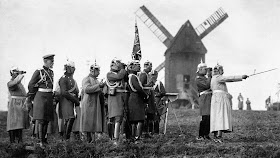In July 2014 the world saw Tammsaare's
Truth & Justice I translated into English for the very first time. The epic five part novel inspired by the writer's childhood home in Vetepere is one of the best depictions of Estonian rural life ever written. For the past 70 years generations of Estonians, Germans, Russians, Latvians and Finns have appreciated the works of Tammsaare and the English speaking world finally has the opportunity to do so too.
Those already familiar with his works may already know a thing or two about Tammsaare but if you are just starting to explore them and want to know more about the great man of Estonian literature, here are twenty things you didn't know about Tammsaare.
1. As a child Tammsaare worked on his parents' farm as a herd boy.
2. Tammsaare was an avid reader and seeker of truth. His favourite author was Fyodor Dostoyevski and he was also fond of the works of Shakespeare, Zoya and Oscar Wilde. At university he was once asked which of Goethe's works he had read. Tammsaare replied 'everything'.
3. Tammsaare was a disciplined, unpretentious and mentally independent person. He strongly believed in freedom of speech and would not accept commissions or grants if it affected his writing integrity. 100% of his writings were his own.
4. When Tammsaare moved to Tallinn in 1919 he worked as a journalist before earning his income from translating, writing articles and from new editions of earlier works.
5.
Postimees was the first Estonian newspaper to publish one of Tammsaare's short stories.
6. In 1929 Tammsaare translated Dostoyevski's
Crime and Punishment into Estonian.
7. Tammsaare didn't get married until he was 41 years old. In 1919 he wed Käthe Veltman, a proof reader who was eighteen years his junior.
8. Tammsaare lived a secluded life in a circle of family and a few close friends from his university days.
9. Playing the violin was one of Tammsaare's great joys in life but he was forced to give it up due to poor health.
10. Tammsaare cheated death twice. He once had a severe case of tuberculosis which saw him spend over a year in a sanatorium in Sochi. Later he had another health scare, this time an intestinal ulcer. He underwent risky surgery in which the doctor told him 'only 2% of patients make it through this' Thankfully, it turned out he was one of the lucky ones!
11. Tammsaare believed a human being should accomplish something significant during his lifetime and not just disappear into oblivion.
12. Tammsaare travelled outside of Estonia only once during his lifetime. That was to Sochi, Russia in 1911.
13. Tammsaare has three museums dedicated to him. His parents' farm in Vetepere where he was born, the house in Sochi where he stayed whilst recovering from TB and his last home in Koidula Street Tallinn.
14. The first work of Tammsaare to be translated into German was 'The Dwarf' in 1936.
15. Tammsaare believed that religious instruction in schools should be replaced by the teaching of the history of religions.
16. The first Tammsaare novel translated into English was actually the last one he wrote.
17. Tammsaare died at his desk in 1940 as a result of a heart attack.
18. At his request when he died, Tammsaare only wanted a single wreath at his funeral. He asked that all the money that would otherwise have been used for flowers or wreaths be placed into a fund to enable his works to be translated into other languages.
19. More of Tammsaare's works have been translated into Latvian and Russian than any other languages.
20. Tammsaare Park located in central Tallinn was named in his honour. The statue of him was erected in 1978 to mark what would have been his 100th birthday.























.jpg)

.jpg)


